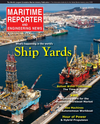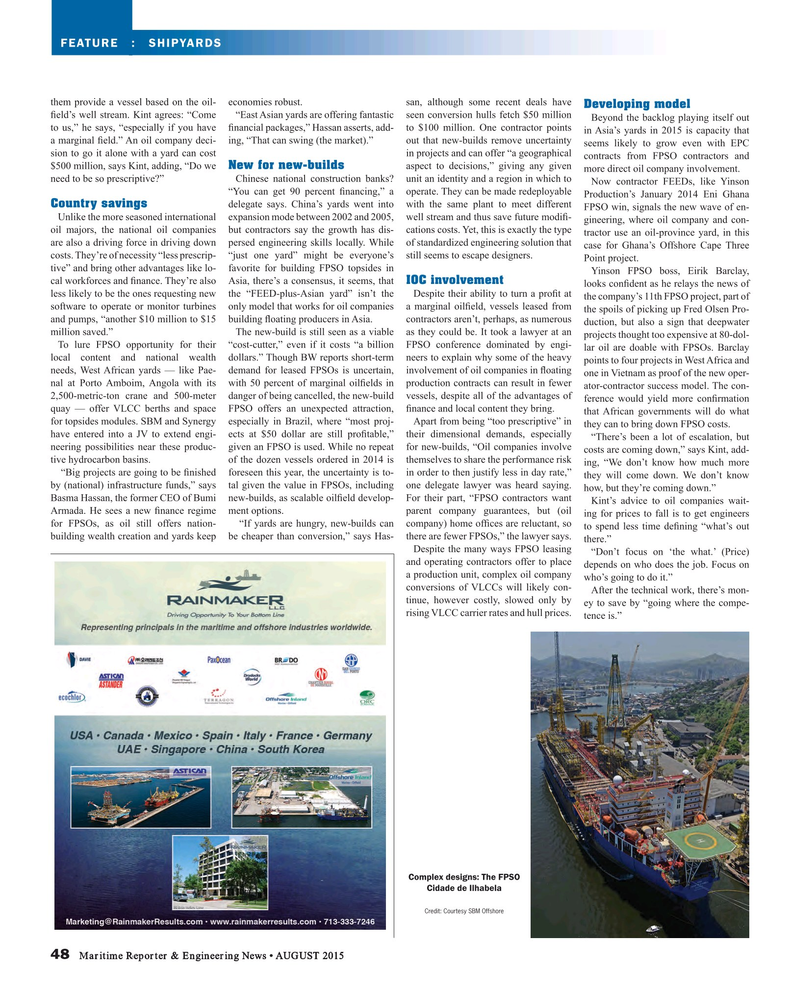
Page 48: of Maritime Reporter Magazine (August 2015)
Shipyard Edition
Read this page in Pdf, Flash or Html5 edition of August 2015 Maritime Reporter Magazine
FEATURE : SHIPYARDS them provide a vessel based on the oil- economies robust. san, although some recent deals have
Developing model ? eld’s well stream. Kint agrees: “Come “East Asian yards are offering fantastic seen conversion hulls fetch $50 million
Beyond the backlog playing itself out to us,” he says, “especially if you have ? nancial packages,” Hassan asserts, add- to $100 million. One contractor points in Asia’s yards in 2015 is capacity that a marginal ? eld.” An oil company deci- ing, “That can swing (the market).” out that new-builds remove uncertainty seems likely to grow even with EPC sion to go it alone with a yard can cost in projects and can offer “a geographical contracts from FPSO contractors and $500 million, says Kint, adding, “Do we aspect to decisions,” giving any given more direct oil company involvement.
New for new-builds need to be so prescriptive?” Chinese national construction banks? unit an identity and a region in which to
Now contractor FEEDs, like Yinson “You can get 90 percent ? nancing,” a operate. They can be made redeployable Production’s January 2014 Eni Ghana delegate says. China’s yards went into with the same plant to meet different FPSO win, signals the new wave of en-
Country savings
Unlike the more seasoned international expansion mode between 2002 and 2005, well stream and thus save future modi? - gineering, where oil company and con- oil majors, the national oil companies but contractors say the growth has dis- cations costs. Yet, this is exactly the type tractor use an oil-province yard, in this are also a driving force in driving down persed engineering skills locally. While of standardized engineering solution that case for Ghana’s Offshore Cape Three costs. They’re of necessity “less prescrip- “just one yard” might be everyone’s still seems to escape designers.
Point project.
tive” and bring other advantages like lo- favorite for building FPSO topsides in
Yinson FPSO boss, Eirik Barclay, cal workforces and ? nance. They’re also Asia, there’s a consensus, it seems, that
IOC involvement looks con? dent as he relays the news of
Despite their ability to turn a pro? t at the company’s 11th FPSO project, part of less likely to be the ones requesting new the “FEED-plus-Asian yard” isn’t the software to operate or monitor turbines only model that works for oil companies a marginal oil? eld, vessels leased from the spoils of picking up Fred Olsen Pro- contractors aren’t, perhaps, as numerous duction, but also a sign that deepwater and pumps, “another $10 million to $15 building ? oating producers in Asia.
The new-build is still seen as a viable as they could be. It took a lawyer at an projects thought too expensive at 80-dol- million saved.”
To lure FPSO opportunity for their “cost-cutter,” even if it costs “a billion FPSO conference dominated by engi- lar oil are doable with FPSOs. Barclay local content and national wealth dollars.” Though BW reports short-term neers to explain why some of the heavy points to four projects in West Africa and demand for leased FPSOs is uncertain, involvement of oil companies in ? oating one in Vietnam as proof of the new oper- needs, West African yards — like Pae- nal at Porto Amboim, Angola with its with 50 percent of marginal oil? elds in production contracts can result in fewer ator-contractor success model. The con- 2,500-metric-ton crane and 500-meter danger of being cancelled, the new-build vessels, despite all of the advantages of ference would yield more con? rmation quay — offer VLCC berths and space FPSO offers an unexpected attraction, ? nance and local content they bring.
that African governments will do what
Apart from being “too prescriptive” in they can to bring down FPSO costs.
for topsides modules. SBM and Synergy especially in Brazil, where “most proj- have entered into a JV to extend engi- ects at $50 dollar are still pro? table,” their dimensional demands, especially “There’s been a lot of escalation, but given an FPSO is used. While no repeat for new-builds, “Oil companies involve costs are coming down,” says Kint, add- neering possibilities near these produc- tive hydrocarbon basins. of the dozen vessels ordered in 2014 is themselves to share the performance risk ing, “We don’t know how much more in order to then justify less in day rate,” they will come down. We don’t know “Big projects are going to be ? nished foreseen this year, the uncertainty is to- by (national) infrastructure funds,” says tal given the value in FPSOs, including one delegate lawyer was heard saying. how, but they’re coming down.”
Basma Hassan, the former CEO of Bumi new-builds, as scalable oil? eld develop- For their part, “FPSO contractors want
Kint’s advice to oil companies wait- parent company guarantees, but (oil ing for prices to fall is to get engineers
Armada. He sees a new ? nance regime ment options.
“If yards are hungry, new-builds can company) home of? ces are reluctant, so to spend less time de? ning “what’s out for FPSOs, as oil still offers nation- building wealth creation and yards keep be cheaper than conversion,” says Has- there are fewer FPSOs,” the lawyer says. there.”
Despite the many ways FPSO leasing “Don’t focus on ‘the what.’ (Price) and operating contractors offer to place depends on who does the job. Focus on a production unit, complex oil company who’s going to do it.” conversions of VLCCs will likely con-
After the technical work, there’s mon- tinue, however costly, slowed only by ey to save by “going where the compe- rising VLCC carrier rates and hull prices. tence is.”
Complex designs: The FPSO
Cidade de Ilhabela
Credit: Courtesy SBM Offshore 48 Maritime Reporter & Engineering News • AUGUST 2015
MR #8 (42-49).indd 48 MR #8 (42-49).indd 48 8/11/2015 9:36:46 AM8/11/2015 9:36:46 AM

 47
47

 49
49
